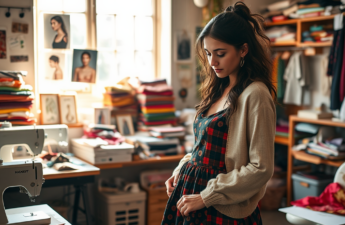Italian fashion has always been a global symbol of style, luxury, and impeccable craftsmanship. Nowadays, a growing number of Italian fashion houses are combining these traditional qualities with a commitment to sustainability. By focusing on eco-friendly materials, ethical labor practices, and innovative waste reduction techniques, these brands are showcasing that fashion can be both stylish and sustainable. In this article, we will explore five notable Italian fashion brands that are leading the way in promoting conscious style. Through their dedication to sustainable practices, these brands are redefining what luxury fashion means in the 21st century.
The Rise of Sustainable Fashion in Italy
Historical Context
Italy has a rich history in fashion, dating back to the Renaissance when Italian cities like Florence and Milan became hubs for textile production. In recent years, however, there has been a significant shift towards sustainability within the industry. This shift is driven by a growing awareness of the environmental impact of traditional fashion manufacturing and an increasing demand for ethical products. Modern Italian brands are integrating sustainability into their core values, setting new standards for luxury fashion.
Why Sustainability Matters in Fashion
Sustainability in fashion is crucial for several reasons. Up to 10% of the world’s carbon emissions are produced by the fashion industry, and conventional clothing production often involves harmful chemicals and unethical labor practices. Consumers are becoming more aware of these issues and are demanding transparency and ethical standards from the brands they support. By choosing sustainable fashion, we can reduce environmental degradation, promote fair labor, and support innovative design solutions that benefit both people and the planet.
1. Stella McCartney
Sustainable Practices
Stella McCartney is renowned for her commitment to sustainability. The brand uses organic materials such as organic cotton and recycled fabrics to minimize environmental impact. Additionally, zero-waste initiatives are implemented in the production process to reduce waste. Stella McCartney excels in balancing high fashion with eco-consciousness, making it a leader in sustainable luxury fashion.
Achievements and Awards
Stella McCartney has received numerous awards and recognitions for her efforts in promoting sustainable fashion. This includes the Green Designer of the Year award and inclusion in various sustainability rankings. The brand continues to push the boundaries of what is possible in eco-friendly fashion, inspiring others in the industry to follow suit.
2. Vivienne Westwood – Italian Branch
Commitment to Ethical Practices
The Italian branch of Vivienne Westwood is deeply committed to ethical practices. The brand prioritizes the ethical sourcing of materials and has established fair trade partnerships to ensure that labor practices are up to standard. These initiatives help to support communities and reduce exploitation in the supply chain, making Vivienne Westwood a pioneer in ethical fashion.
Community Involvement
Vivienne Westwood is not only focused on sustainability but also on community involvement. Through various charity initiatives and advocacy for environmental policies, the brand actively contributes to positive societal changes. These efforts demonstrate how fashion brands can take an active role in promoting sustainability beyond their immediate industry.
Here are some specific ways Vivienne Westwood engages with the community:
- Organizing charity events to raise funds for environmental causes.
- Collaborating with NGOs to promote sustainable fashion practices globally.
3. Gucci
Eco-Friendly Innovations
Gucci is setting a high bar with its eco-friendly innovations. The brand has introduced sustainable collections such as Gucci Off The Grid, which features items made from recycled and organic materials. Additionally, Gucci has committed to being carbon neutral, working to offset its carbon footprint through various environmental initiatives. These steps showcase Gucci’s dedication to sustainability and innovation in luxury fashion.
Certifications and Recognitions
Gucci has been recognized for its comprehensive sustainability initiatives. The brand holds numerous certifications that attest to its commitment to environmental and ethical standards, such as the REACH regulation for chemical safety. These recognitions solidify Gucci’s status as a leader in sustainable luxury fashion.
4. Giorgio Armani
Green Manufacturing
Giorgio Armani has made strides in green manufacturing processes. The brand uses eco-friendly fabrics such as organic cotton and linen, and adopts low-impact manufacturing techniques to reduce its environmental footprint. These steps not only make Giorgio Armani’s products more sustainable but also set an example for other luxury brands to follow.
Corporate Social Responsibility
Beyond manufacturing, Giorgio Armani is active in corporate social responsibility. The brand supports various community and environmental programs, such as initiatives to improve water conservation and efforts to reduce waste. These actions illustrate Armani’s broader commitment to sustainability and social responsibility.
To better understand the sustainable practices of these brands, here is a comparison table:
| Brand | Sustainable Materials | Certifications | Community Initiatives |
|---|---|---|---|
| Stella McCartney | Organic cotton, recycled fabrics | Green Designer of the Year | Zero-waste initiatives |
| Vivienne Westwood | Ethical sourcing | N/A | Charity events, NGO collaborations |
| Gucci | Recycled and organic materials | REACH regulation | Carbon neutrality |
| Giorgio Armani | Organic cotton, linen | N/A | Water conservation efforts |
| Eileen Fisher – Italian Line | Recycled materials | N/A | Take-back initiatives |
5. Eileen Fisher – Italian Line
Circular Fashion Model
Eileen Fisher’s Italian line is a perfect representation of the circular fashion model. The brand emphasizes recycling and upcycling, with programs that encourage customers to return old garments for a new life. This approach not only reduces waste but also fosters a more sustainable fashion lifecycle. Eileen Fisher’s commitment to circular fashion makes it a standout in the sustainable fashion industry.
Transparency in Operations
Eileen Fisher is dedicated to transparency in its operations. The brand openly discloses its sustainable practices, providing detailed sustainability reports to inform consumers about its efforts. This level of transparency ensures accountability and helps build trust with consumers who are looking to make more conscious fashion choices.
Here are two key aspects of Eileen Fisher’s circular fashion model:
- Recycling programs that transform old garments into new ones.
- Upcycling initiatives that give a second life to clothing materials.
The Future of Sustainable Italian Fashion
Emerging Trends
As the demand for sustainable fashion continues to grow, several emerging trends are shaping the industry. One significant trend is the increased use of technology to enhance sustainable practices. Virtual fitting rooms, 3D knitting, and blockchain for supply chain transparency are just a few examples. Additionally, the second-hand and vintage markets are experiencing significant growth, providing consumers with more sustainable shopping options.
Consumer Role
Consumers play a crucial role in driving the future of sustainable fashion. By making informed choices and supporting brands committed to ethical and eco-friendly practices, consumers can promote greater sustainability within the industry. Here are a few tips for shopping sustainably:
Here is a list of consumer tips:
- Choose quality over quantity – invest in high-quality pieces that last longer.
- Support brands with transparent and ethical practices.
Conclusion
Sustainable fashion in Italy is paving the way for a more ethical and environmentally-friendly industry. Through innovative practices and a commitment to transparency, brands like Stella McCartney, Vivienne Westwood, Gucci, Giorgio Armani, and Eileen Fisher are showing that luxury and sustainability can go hand-in-hand. As the industry evolves, the role of conscious consumers will remain crucial in supporting and encouraging more brands to adopt sustainable practices.
FAQs
1. What does sustainable fashion mean?
Sustainable fashion refers to clothing and accessories that are produced in ways that are environmentally friendly and socially responsible. This often includes the use of eco-friendly materials, ethical labor practices, and reducing waste.
2. How can I identify a sustainable fashion brand?
Look for certifications such as Fair Trade, Global Organic Textile Standard (GOTS), and Carbon Neutral certifications. Additionally, brands often disclose their sustainable practices on their websites or product labels.
3. Is sustainable fashion more expensive?
While some sustainable fashion items can be more expensive due to higher production costs, they often offer better quality and longevity. Investing in sustainable pieces can be more cost-effective in the long run.
4. Why is transparency important in sustainable fashion?
Transparency allows consumers to make informed choices by understanding how and where their clothes are made. It also holds brands accountable for their environmental and ethical practices.
5. How can I contribute to sustainable fashion as a consumer?
You can support sustainable fashion by buying from ethical brands, purchasing second-hand clothes, recycling or donating old garments, and choosing quality over quantity.


